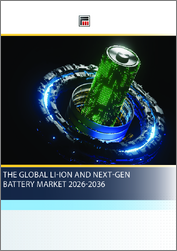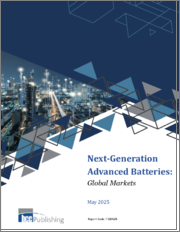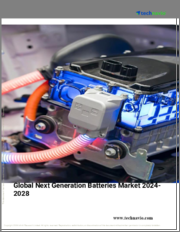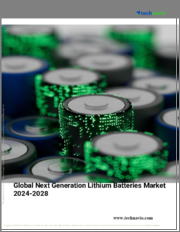
|
시장보고서
상품코드
1574882
차세대 배터리 시장 규모, 점유율, 동향 분석 리포트 : 기술별, 용도별, 지역별, 부문 예측(2024-2030년)Next Generation Batteries Market Size, Share & Trends Analysis Report By Technology (Lithium-Sulfur Batteries, Solid-State Batteries), By Application (Electric Vehicles (EVs), Consumer Electronics), By Region, And Segment Forecasts, 2024 - 2030 |
||||||
차세대 배터리 시장 동향 :
세계의 차세대 배터리 시장 규모는 2023년에 17억 6,000만 달러로 추정되며, 2024-2030년 CAGR 8.4%로 성장할 것으로 예측됩니다.
세계 차세대 배터리 시장은 특히 전기자동차(EV) 및 재생에너지 분야의 첨단 에너지 저장 솔루션에 대한 수요 증가에 힘입어 꾸준히 성장하고 있습니다. 전 세계 산업계와 정부가 청정 에너지원으로의 전환에 집중하면서 혁신적인 배터리 기술에 대한 요구가 더욱 두드러지고 있습니다. 고체 배터리, 리튬 황 배터리, 나트륨 이온 배터리와 같은 차세대 배터리는 기존 리튬이온 배터리보다 에너지 밀도가 높고, 안전 기능이 강화되었으며, 성능이 향상되었습니다.
기술의 지속적인 발전과 연구개발에 대한 투자 증가로 인해 향후 수년간 시장이 크게 성장할 것으로 예상됩니다. 전기자동차가 고성능 배터리 수요의 대부분을 계속 주도하는 한편, 재생에너지 분야의 성장은 효율적인 에너지 저장 솔루션의 필요성을 더욱 가속화시키고 있습니다. 또한 아시아태평양, 북미, 유럽 등 세계 주요 지역이 배터리 인프라 및 제조에 많은 투자를 하고 있으며, 이는 전체 시장의 성장 궤도에 기여하고 있습니다.
산업계가 지속가능성과 에너지 효율을 점점 더 우선시함에 따라 차세대 배터리 시장은 큰 성장을 이룰 수 있는 위치에 있습니다. 기업은 보다 깨끗하고 효율적인 에너지 저장 솔루션에 대한 수요 증가에 대응하기 위해 첨단 기술을 개발하고 있으며, 각국 정부는 첨단 배터리 사용을 촉진하기 위한 정책 및 인센티브를 도입하고 있습니다. 이러한 시장 성장은 에너지 효율이 높은 기술을 채택하고 기존 에너지 저장 방식에 대한 의존도를 낮추는 큰 추세를 반영하고 있습니다.
목차
제1장 조사 방법과 범위
제2장 개요
제3장 차세대 배터리 시장의 변수, 동향, 범위
- 시장 계통 전망
- 업계 밸류체인 분석
- 원재료의 동향
- 제조업의 동향
- 이익률 분석
- 판매채널 분석
- 기술 개요/타임라인
- 규제 프레임워크
- 표준과 컴플라이언스
- 안전성
- 시장 역학
- 시장 성장 촉진요인 분석
- 시장 성장 억제요인 분석
- 시장이 해결해야 할 과제 분석
- 시장 기회 분석
- 비즈니스 환경 분석
- 업계 분석 - Porter의 산업 분석
- PESTEL 분석
- 환경, 사회, 거버넌스(ESG) 구상이 차세대 배터리 시장에 미치는 영향
- 시장의 차별화
- 규제 준수
- 업계 협업
- 브랜드 가치의 향상
- 소비자의 요구에 부응
제4장 차세대 배터리 시장 : 기술 추정·동향 분석
- 기술 변동 분석과 시장 점유율, 2023년과 2030년
- 리튬-황 배터리
- 고체 배터리
- 리튬 공기 배터리
- 플로우 배터리
제5장 차세대 배터리 시장 : 용도 추정·동향 분석
- 용도 변동 분석과 시장 점유율, 2023년과 2030년
- 전기자동차(EV)
- 가전
- 에너지 저장 시스템(ESS)
- 항공우주 및 방위
제6장 차세대 배터리 시장 : 지역 추정·동향 분석
- 주요 포인트
- 지역 변동 분석과 시장 점유율, 2023년과 2030년
- 북미
- 기술별, 2018-2030년
- 용도별, 2018-2030년
- 미국
- 캐나다
- 멕시코
- 유럽
- 기술별, 2018-2030년
- 용도별, 2018-2030년
- 독일
- 영국
- 프랑스
- 이탈리아
- 스페인
- 아시아태평양
- 기술별, 2018-2030년
- 용도별, 2018-2030년
- 중국
- 인도
- 일본
- 한국
- 중남미
- 기술별, 2018-2030년
- 용도별, 2018-2030년
- 브라질
- 아르헨티나
- 중동 및 아프리카
- 기술별, 2018-2030년
- 용도별, 2018-2030년
- 사우디아라비아
- 남아프리카공화국
제7장 경쟁 구도
- 세계의 주요 기업과 최근 동향, 그리고 업계에 대한 영향
- 주요 기업/경쟁의 분류(주요 이노베이터, 시장 리더, 신규 기업)
- 주요 원재료 판매업체 및 채널 파트너 리스트
- List of Potential Customers, by Application
- 기업의 시장 점유율과 포지션 분석, 2023년
- 기업 히트맵 분석
- 전략 지도제작
- 확대
- 협업/파트너십/계약
- 신소재의 발매
- 합병과 인수
- 연구개발
- 기타
제8장 기업 리스트/개요
- LG Chemicals
- 회사 개요
- 재무 실적
- 제품 벤치마킹
- Phinergy
- 회사 개요
- 재무 실적
- 제품 벤치마킹
- Amprius Inc.
- 회사 개요
- 재무 실적
- 제품 벤치마킹
- Mitsubishi Chemical
- 회사 개요
- 재무 실적
- 제품 벤치마킹
- Seeo
- 회사 개요
- 재무 실적
- 제품 벤치마킹
- Panasonic Corporation
- 회사 개요
- 재무 실적
- 제품 벤치마킹
- 사이 온 파워
- 회사 개요
- 재무 실적
- 제품 벤치마킹
- Sion Power
- 회사 개요
- 재무 실적
- 제품 벤치마킹
- Sion Power
- 회사 개요
- 재무 실적
- 제품 벤치마킹
- Envia Systems Inc.
- 회사 개요
- 재무 실적
- 제품 벤치마킹
- Ambri Inc.
- 회사 개요
- 재무 실적
- 제품 벤치마킹
- Hitachi
- 회사 개요
- 재무 실적
- 제품 벤치마킹
제9장 전략적 권장사항/애널리스트의 시점
KSA 24.11.01Next Generation Batteries Market Trends:
The global next generation batteries market size was estimated at USD 1.76 billion in 2023 and is expected to grow at a CAGR of 8.4% from 2024 to 2030. The global next-generation batteries market is growing steadily, driven by the increasing demand for advanced energy storage solutions, particularly for electric vehicles (EVs) and renewable energy sectors. As industries and governments around the world focus on transitioning to cleaner energy sources, the need for innovative battery technologies has become more pronounced. Next-generation batteries, such as solid-state, lithium-sulfur, and sodium-ion batteries, offer improved energy density, enhanced safety features, and better performance over traditional lithium-ion batteries.
The market is expected to see considerable expansion in the coming years due to ongoing technological advancements and rising investments in research and development. Electric vehicles continue to drive much of the demand for high-performance batteries, while the growing renewable energy sector further accelerates the need for efficient energy storage solutions. Additionally, major global regions such as Asia Pacific, North America, and Europe are investing significantly in battery infrastructure and manufacturing, contributing to the market's overall growth trajectory.
As industries increasingly prioritize sustainability and energy efficiency, the next-generation batteries market is positioned for significant growth. Companies are developing cutting-edge technologies to meet the rising demand for cleaner, more efficient energy storage solutions, while governments around the world are introducing policies and incentives to promote the use of advanced batteries. This market growth reflects a larger trend toward adopting energy-efficient technologies and reducing reliance on conventional energy storage methods.
Global Next Generation Batteries Market Report Segmentation
This report forecasts revenue growth at global, regional, and country levels and provides an analysis of the latest industry trends in each of the sub-segments from 2018 to 2030. For this study, Grand View Research has segmented the global next generation batteries market report based on the technology, application, and region:
- Technology Outlook (Revenue, USD Million, 2018 - 2030)
- Lithium-Sulfur Batteries
- Solid-State Batteries
- Lithium-air batteries
- Flow Batteries
- Application Outlook (Revenue, USD Million, 2018 - 2030)
- Electric Vehicles (EVs)
- Consumer Electronics
- Energy Storage Systems (ESS)
- Aerospace and Defense
- Regional Outlook (Revenue, USD Million, 2018 - 2030)
- North America
- U.S.
- Canada
- Mexico
- Europe
- Germany
- UK
- France
- Italy
- Spain
- Asia Pacific
- China
- India
- Japan
- South Korea
- Central & South America
- Brazil
- Argentina
- Middle East & Africa
- Saudi Arabia
- South Africa
Table of Contents
Chapter 1. Methodology and Scope
- 1.1. Market Segmentation & Scope
- 1.2. Market Definition
- 1.3. Information Procurement
- 1.3.1. Purchased Database
- 1.3.2. GVR's Internal Database
- 1.3.3. Secondary Materials & Third-Party Perspectives
- 1.3.4. Primary Research
- 1.4. Information Analysis
- 1.4.1. Data Analysis Models
- 1.5. Market Formulation & Data Visualization
- 1.6. Data Validation & Publishing
- 1.7. List of Abbreviations
Chapter 2. Executive Summary
- 2.1. Market Outlook, 2023
- 2.2. Segmental Outlook
- 2.2.1. Technology Outlook
- 2.2.2. Application Outlook
- 2.3. Competitive Landscape Snapshot
Chapter 3. Next Generation Batteries Market Variables, Trends, and Scope
- 3.1. Market Lineage Outlook
- 3.2. Industry Value Chain Analysis
- 3.2.1. Raw Material Trends
- 3.2.2. Manufacturing Trends
- 3.2.3. Profit Margin Analysis
- 3.2.4. Sales Channel Analysis
- 3.3. Technology Overview/ Timeline
- 3.4. Regulatory Framework
- 3.4.1. Standard & Compliance
- 3.4.2. Safety
- 3.5. Market Dynamics
- 3.5.1. Market Driver Analysis
- 3.5.2. Market Restraint Analysis
- 3.5.3. Market Challenges Analysis
- 3.5.4. Market Opportunity Analysis
- 3.6. Business Environment Analysis
- 3.6.1. Industry Analysis - Porter's
- 3.6.1.1. Supplier Power
- 3.6.1.2. Buyer Power
- 3.6.1.3. Substitution Threat
- 3.6.1.4. Threat from New Entrant
- 3.6.1.5. Competitive Rivalry
- 3.6.2. PESTEL Analysis
- 3.6.2.1. Political Landscape
- 3.6.2.2. Environmental Landscape
- 3.6.2.3. Social Landscape
- 3.6.2.4. Technology Landscape
- 3.6.2.5. Economic Landscape
- 3.6.2.6. Legal Landscape
- 3.6.1. Industry Analysis - Porter's
- 3.7. Impact of Environmental, Social, and Governance (ESG) initiatives on the Next Generation Batteries Market
- 3.7.1. Market Differentiation
- 3.7.2. Regulatory Compliance
- 3.7.3. Industry Collaboration
- 3.7.4. Enhanced Brand Value
- 3.7.5. Addressing Consumer Demands
Chapter 4. Next Generation Batteries Market: Technology Estimates & Trend Analysis
- 4.1. Technology Movement Analysis & Market Share, 2023 & 2030
- 4.2. Lithium-Sulfur Batteries
- 4.2.1. Market estimates and forecasts, 2018 - 2030 (USD Million)
- 4.3. Solid-State Batteries
- 4.3.1. Market estimates and forecasts, 2018 - 2030 (USD Million)
- 4.4. Lithium-air Batteries
- 4.4.1. Market estimates and forecasts, 2018 - 2030 (USD Million)
- 4.5. Flow Batteries
- 4.5.1. Market estimates and forecasts, 2018 - 2030 (USD Million)
Chapter 5. Next Generation Batteries Market: Application Estimates & Trend Analysis
- 5.1. Application Movement Analysis & Market Share, 2023 & 2030
- 5.2. Electric Vehicles (EVs)
- 5.2.1. Market estimates and forecasts, 2018 - 2030 (USD Million)
- 5.3. Consumer Electronics
- 5.3.1. Market estimates and forecasts, 2018 - 2030 (USD Million)
- 5.4. Energy Storage Systems (ESS)
- 5.4.1. Market estimates and forecasts, 2018 - 2030 (USD Million)
- 5.5. Aerospace and Defense
- 5.5.1. Market estimates and forecasts, 2018 - 2030 (USD Million)
Chapter 6. Next Generation Batteries Market: Regional Estimates & Trend Analysis
- 6.1. Key Takeaways
- 6.2. Regional Movement Analysis & Market Share, 2023 & 2030
- 6.3. North America
- 6.3.1. Market estimates and forecasts, 2018 - 2030 (USD Million)
- 6.3.2. Market estimates and forecasts, by technology, 2018 - 2030 (USD Million)
- 6.3.3. Market estimates and forecasts, by application, 2018 - 2030 (USD Million)
- 6.3.4. U.S.
- 6.3.4.1. Market estimates and forecasts, 2018 - 2030 (USD Million)
- 6.3.4.2. Market estimates and forecasts, by technology, 2018 - 2030 (USD Million)
- 6.3.4.3. Market estimates and forecasts, by application, 2018 - 2030 (USD Million)
- 6.3.5. Canada
- 6.3.5.1. Market estimates and forecasts, 2018 - 2030 (USD Million)
- 6.3.5.2. Market estimates and forecasts, by technology, 2018 - 2030 (USD Million)
- 6.3.5.3. Market estimates and forecasts, by application, 2018 - 2030 (USD Million)
- 6.3.6. Mexico
- 6.3.6.1. Market estimates and forecasts, 2018 - 2030 (USD Million)
- 6.3.6.2. Market estimates and forecasts, by technology, 2018 - 2030 (USD Million)
- 6.3.6.3. Market estimates and forecasts, by application, 2018 - 2030 (USD Million)
- 6.4. Europe
- 6.4.1. Market estimates and forecasts, 2018 - 2030 (USD Million)
- 6.4.2. Market estimates and forecasts, by technology, 2018 - 2030 (USD Million)
- 6.4.3. Market estimates and forecasts, by application, 2018 - 2030 (USD Million)
- 6.4.4. Germany
- 6.4.4.1. Market estimates and forecasts, 2018 - 2030 (USD Million)
- 6.4.4.2. Market estimates and forecasts, by technology, 2018 - 2030 (USD Million)
- 6.4.4.3. Market estimates and forecasts, by application, 2018 - 2030 (USD Million)
- 6.4.5. UK
- 6.4.5.1. Market estimates and forecasts, 2018 - 2030 (USD Million)
- 6.4.5.2. Market estimates and forecasts, by technology, 2018 - 2030 (USD Million)
- 6.4.5.3. Market estimates and forecasts, by application, 2018 - 2030 (USD Million)
- 6.4.6. France
- 6.4.6.1. Market estimates and forecasts, 2018 - 2030 (USD Million)
- 6.4.6.2. Market estimates and forecasts, by technology, 2018 - 2030 (USD Million)
- 6.4.6.3. Market estimates and forecasts, by application, 2018 - 2030 (USD Million)
- 6.4.7. Italy
- 6.4.7.1. Market estimates and forecasts, 2018 - 2030 (USD Million)
- 6.4.7.2. Market estimates and forecasts, by technology, 2018 - 2030 (USD Million)
- 6.4.7.3. Market estimates and forecasts, by application, 2018 - 2030 (USD Million)
- 6.4.8. Spain
- 6.4.8.1. Market estimates and forecasts, 2018 - 2030 (USD Million)
- 6.4.8.2. Market estimates and forecasts, by technology, 2018 - 2030 (USD Million)
- 6.4.8.3. Market estimates and forecasts, by application, 2018 - 2030 (USD Million)
- 6.5. Asia Pacific
- 6.5.1. Market estimates and forecasts, 2018 - 2030 (USD Million)
- 6.5.2. Market estimates and forecasts, by technology, 2018 - 2030 (USD Million)
- 6.5.3. Market estimates and forecasts, by application, 2018 - 2030 (USD Million)
- 6.5.4. China
- 6.5.4.1. Market estimates and forecasts, 2018 - 2030 (USD Million)
- 6.5.4.2. Market estimates and forecasts, by technology, 2018 - 2030 (USD Million)
- 6.5.4.3. Market estimates and forecasts, by application, 2018 - 2030 (USD Million)
- 6.5.5. India
- 6.5.5.1. Market estimates and forecasts, 2018 - 2030 (USD Million)
- 6.5.5.2. Market estimates and forecasts, by technology, 2018 - 2030 (USD Million)
- 6.5.5.3. Market estimates and forecasts, by application, 2018 - 2030 (USD Million)
- 6.5.6. Japan
- 6.5.6.1. Market estimates and forecasts, 2018 - 2030 (USD Million)
- 6.5.6.2. Market estimates and forecasts, by technology, 2018 - 2030 (USD Million)
- 6.5.6.3. Market estimates and forecasts, by application, 2018 - 2030 (USD Million)
- 6.5.7. South Korea
- 6.5.7.1. Market estimates and forecasts, 2018 - 2030 (USD Million)
- 6.5.7.2. Market estimates and forecasts, by technology, 2018 - 2030 (USD Million)
- 6.5.7.3. Market estimates and forecasts, by application, 2018 - 2030 (USD Million)
- 6.6. Central & South America
- 6.6.1. Market estimates and forecasts, 2018 - 2030 (USD Million)
- 6.6.2. Market estimates and forecasts, by technology, 2018 - 2030 (USD Million)
- 6.6.3. Market estimates and forecasts, by application, 2018 - 2030 (USD Million)
- 6.6.4. Brazil
- 6.6.4.1. Market estimates and forecasts, 2018 - 2030 (USD Million)
- 6.6.4.2. Market estimates and forecasts, by technology, 2018 - 2030 (USD Million)
- 6.6.4.3. Market estimates and forecasts, by application, 2018 - 2030 (USD Million)
- 6.6.5. Argentina
- 6.6.5.1. Market estimates and forecasts, 2018 - 2030 (USD Million)
- 6.6.5.2. Market estimates and forecasts, by technology, 2018 - 2030 (USD Million)
- 6.6.5.3. Market estimates and forecasts, by application, 2018 - 2030 (USD Million)
- 6.7. Middle East & Africa
- 6.7.1. Market estimates and forecasts, 2018 - 2030 (USD Million)
- 6.7.2. Market estimates and forecasts, by technology, 2018 - 2030 (USD Million)
- 6.7.3. Market estimates and forecasts, by application, 2018 - 2030 (USD Million)
- 6.7.4. Saudi Arabia
- 6.7.4.1. Market estimates and forecasts, 2018 - 2030 (USD Million)
- 6.7.4.2. Market estimates and forecasts, by technology, 2018 - 2030 (USD Million)
- 6.7.4.3. Market estimates and forecasts, by application, 2018 - 2030 (USD Million)
- 6.7.5. South Africa
- 6.7.5.1. Market estimates and forecasts, 2018 - 2030 (USD Million)
- 6.7.5.2. Market estimates and forecasts, by technology, 2018 - 2030 (USD Million)
- 6.7.5.3. Market estimates and forecasts, by application, 2018 - 2030 (USD Million)
Chapter 7. Competitive Landscape
- 7.1. Key Global Players & Recent Developments & Their Impact On the Industry
- 7.2. Key Company/Competition Categorization (Key innovators, Market leaders, emerging players)
- 7.3. List of key Raw Material Distributors and Channel Partners
- 7.4. List of Potential Customers, by Application
- 7.5. Company Market Share & Position Analysis, 2023
- 7.6. Company Heat Map Analysis
- 7.7. Strategy Mapping
- 7.7.1. Expansion
- 7.7.2. Collaboration/ Partnerships/ Agreements
- 7.7.3. New Material launches
- 7.7.4. Mergers & Acquisitions
- 7.7.5. Research & Development
- 7.7.6. Others
Chapter 8. Company Listing / Profiles
- 8.1. LG Chemicals
- 8.1.1. Company Overview
- 8.1.2. Financial Performance
- 8.1.3. Product Benchmarking
- 8.2. Phinergy
- 8.2.1. Company Overview
- 8.2.2. Financial Performance
- 8.2.3. Product Benchmarking
- 8.3. Amprius Inc.
- 8.3.1. Company Overview
- 8.3.2. Financial Performance
- 8.3.3. Product Benchmarking
- 8.4. Mitsubishi Chemical
- 8.4.1. Company Overview
- 8.4.2. Financial Performance
- 8.4.3. Product Benchmarking
- 8.5. Seeo
- 8.5.1. Company Overview
- 8.5.2. Financial Performance
- 8.5.3. Product Benchmarking
- 8.6. Panasonic Corporation
- 8.6.1. Company Overview
- 8.6.2. Financial Performance
- 8.6.3. Product Benchmarking
- 8.7. Sion Power
- 8.7.1. Company Overview
- 8.7.2. Financial Performance
- 8.7.3. Product Benchmarking
- 8.8. Envia Systems Inc.
- 8.8.1. Company Overview
- 8.8.2. Financial Performance
- 8.8.3. Product Benchmarking
- 8.9. Ambri Inc.
- 8.9.1. Company Overview
- 8.9.2. Financial Performance
- 8.9.3. Product Benchmarking
- 8.10. Hitachi
- 8.10.1. Company Overview
- 8.10.2. Financial Performance
- 8.10.3. Product Benchmarking
Chapter 9. Strategic Recommendations/ Analyst Perspective
(주말 및 공휴일 제외)
















